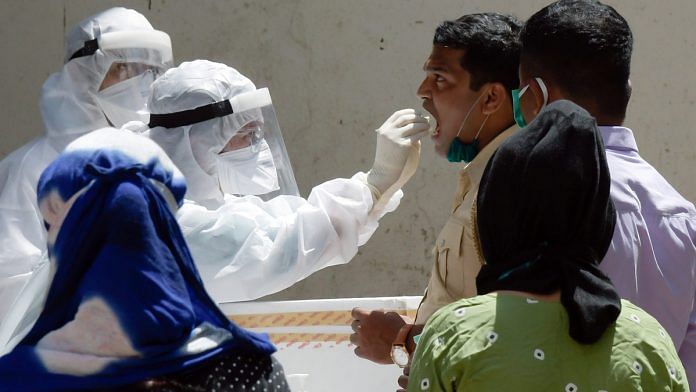New Delhi: India has largely been able to control the transmission of Covid-19 in the country since the lockdown, the government’s expert committee said Thursday.
After 30 days of lockdown, the growth in new infection cases has not been exponential but linear i.e., cases have been growing at a constant rate and not rapidly. This means India’s strategy has been working, said C.K. Mishra, secretary, Ministry of Environment and chairman of the task force on hospital preparedness.
During the month of lockdown, India’s focus has been on cutting the transmission of the virus, slowing down the rate of new cases and ramping up testing, Mishra added.
From conducting 15,000 tests as on 23 March, India has been able to scale that number to above five lakh tests on 22 April.
The number of positive cases have remained at a constant 4.5 per cent of the total number of cases, even though the number of tests were increased 24 times since 25 March, Misra said, adding that this rate was better than other developed countries.
When Italy completed testing five lakh samples on 31 March, it reported 1 lakh cases. The United Kingdom had done so 20 April, and reported 1.2 lakh cases. Similarly, the United States (26 March) and Turkey (16 April) both reported 8,000 cases. India reported 20,000 when it tested 5 lakh samples, Mishra said.
He added that the 30 days of lockdown were utilised for ramping up testing and hospital capacity.
Also read: Decline in India’s Covid R0 and how effective is the ‘test, test, test’ mantra
Hospital capacity scaled up
While the hospital infrastructure is enough for the current 16,600-odd active cases, the strategy has been to prepare for a future when cases rise, said Mishra, who added that the Centre is now looking at ramping facilities at the district level.
India has increased its total dedicated hospitals 3.5 times and increased its hospital isolation beds by 3.6 times since last month, said Mishra.
There are 736 dedicated Covid-19 hospitals, 1.94 lakh isolation beds and 12,371 ventilators available for patients.
Misra said that most patients do not need to go to the hospitals and only five per cent of critical patients require ventilator support.
Eighty per cent of patients with mild symptoms can get better with supportive treatment in Covid care centres and only 15 per cent with slightly serious symptoms will need oxygen support, which is available in dedicated health centres.
“We have seen oxygen therapy is very critical and can be useful to save lives … Our focus is now on ramping up oxygen facilities,” said Mishra.
Also read: Ventilator demand makes Singapore’s richest man richer by $3.5 billion
Test early
Most of the deaths, the government said, were due to a delay in seeking care.
“Patients wait at home till (it’s) too long and only reach the hospital when the symptoms are severe because they are afraid of the stigma,” said Dr Randeep Guleria, director of All Indian Institute of Medical Sciences (AIIMS). He added that people need to be encouraged to get tested early.
The AIIMS director also said India has been using antimalarial drug hydroxychloroquine with antibiotic azithromycin to treat Covid-19 patients and has seen encouraging results with convalescent plasma therapy, a treatment where plasma from recovered patients is injected in critical patients when other treatments fail.
Also read: India ready for clinical trial of plasma treatment for critical Covid-19 patients



